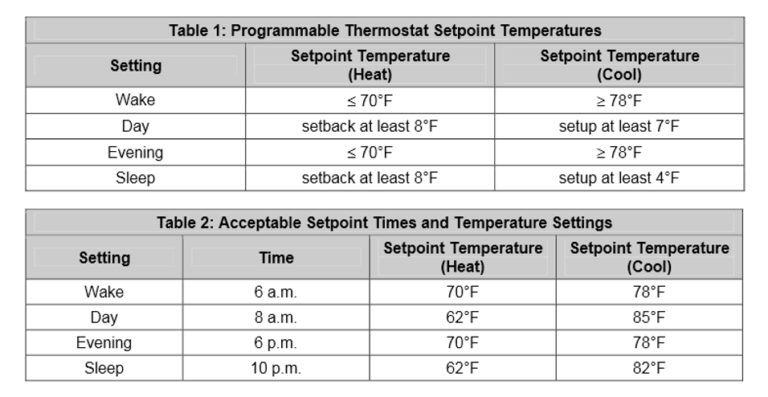
For customers with forced air zoning, you may tweak many variables to increase the energy efficiency of their HVAC zoning system, one of the variables being the thermostat. We put together our most effective thermostat hacks for HVAC zoning systems.
Many smart and programmable thermostats offer more advanced system flexibility than traditional equipment and can link to enhanced comfort and reduced operational cost of equipment. Like most mechanical systems, HVAC zoning systems have a range of operations that can directly affect energy usage. With hot and cold spots common in homes and buildings with traditional equipment, zoning can economically comfort those areas when set up for effective thermostat operation.
Thermostat Schedule
Smart and programmable thermostats nowadays have increased functionality to the point that they can run a schedule to take advantage of the time zones not being used. Temperature setback can potentially save significant energy (up to 10% as stated by energy.gov) over one constant temperature because equipment run time can be reduced. Equipment runtime is reduced by allowing zones to be comfortable only while the zone is occupied. All Arzel panels are compatible with any 24v, smart, or programmable thermostats.
The table below is the ENERGY STAR recommendation for temperature setback for programmable thermostats with at least four changeovers (wake, day, evening, sleep). Using this table as a guideline, the mentioned energy savings are possible.

It should be noted that ENERGY STAR suspended the ENERGY STAR label for programmable thermostats back in 2009. While ENERGY STAR does seem to agree that programmable thermostats can save significant amounts of energy, the amount of energy they save depends a lot on how they are used. ENERGY STAR stands behind education and enhanced usability to encourage users to take effective steps towards energy savings. This suggests informing homeowners about the proper use of thermostat programmability is critical in a continued effort to lower their HVAC costs and increase overall environmental benefits.
Thermostat Location
HVAC Equipment runtime can be further optimized by reducing or eliminating over-conditioning. For a traditional HVAC with one thermostat on the first floor of a two-story home, the user may compensate for increased second-floor temperatures in summer by lowering the first-floor thermostat to below comfort level. In this example, the main floor is over-conditioned, which may cause an increase in equipment runtime due to the temperature difference between floors. Zoning can remedy this temperature compensation by placing the thermostats strategically. Thermostat location is essential to energy efficiency and has the following standard guidelines:
Choose thermostat location wisely for an accurate representation of zonal temperature. Larger and generally most often occupied rooms such as a master bedroom may deserve a thermostat (zone) of their own. With a room like the master bedroom not being zoned, unoccupied spaces in the home may be over-conditioned to reach comfort in that room. Other rooms on a floor (smaller and used less frequently) may be better suited if combined into a zone with perhaps a centrally located thermostat (if the rooms have similar comfort patterns). If they don’t have similar comfort patterns and best avoid installing booster fans or some other solution to reach the extremities of homes, a thermostat/zone of their own should be considered.
We hope you’ve found these thermostat hacks for HVAC zoning systems helpful. Taking advantage of temperature setbacks and placing the thermostat strategically based on the homeowners’ comfort needs can not only enhance comfort but reduce the operational cost of equipment and bring energy savings for your customer. To learn more about the basic application design process to help maximize the comfort of your customers, be sure to schedule a free webinar on our 5 rules of Zoning or contact our technical support team.
Any HVAC professional will tell you that multi-stage equipment is great. These powerful air conditioning machines can achieve better comfort and better energy efficiency. We wanted to take a moment to explain why HVAC zoning makes multi-stage equipment even better. Here’s how we’re optimizing multi-stage equipment with Arzel Zoning. Why would you zone multi-stage equipment? […]
There’s been a big change in HVAC this year with the introduction of A2L refrigerants. By now, most of our customers have done some kind of training on R-32 or R-454B refrigerant. The new class of refrigerants does have some impacts on zoning. Here’s what you need to know about HVAC zoning with A2L refrigerants. […]
So you’re ready to install zoning in your customer’s home or business. Congratulations! Let’s make the next part as easy as possible, with this advice on getting your HVAC zoning system kit. Components of a zoning system kit There are just five parts you’ll need to install an Arzel Zoning system. A zoning panel Zoning […]
Can you add zones to an existing HVAC system? Yes! Arzel Zoning has been doing exactly that for more than 40 years. Our retrofit zoning options make it as seamless as possible. Here’s how it works. Why would clients want more than one zone? Let’s start with why a home or business owner would want […]